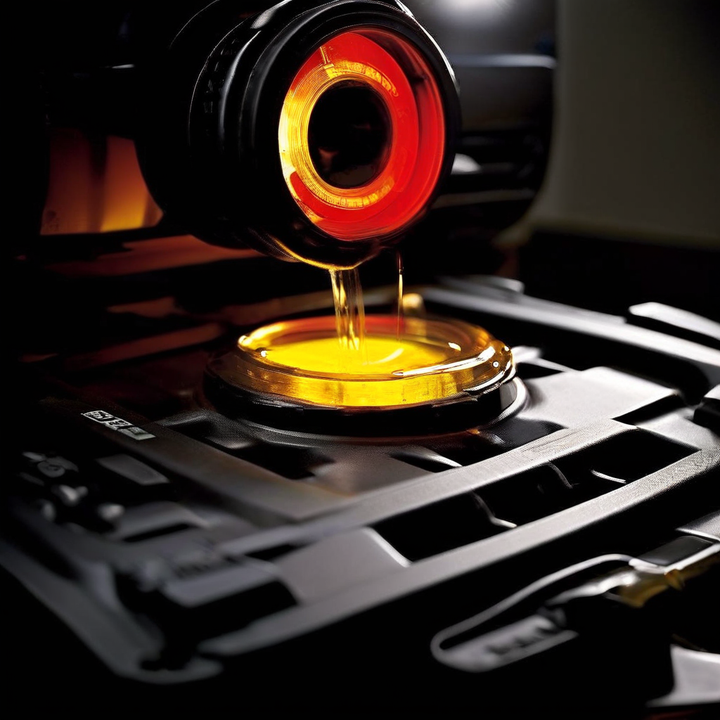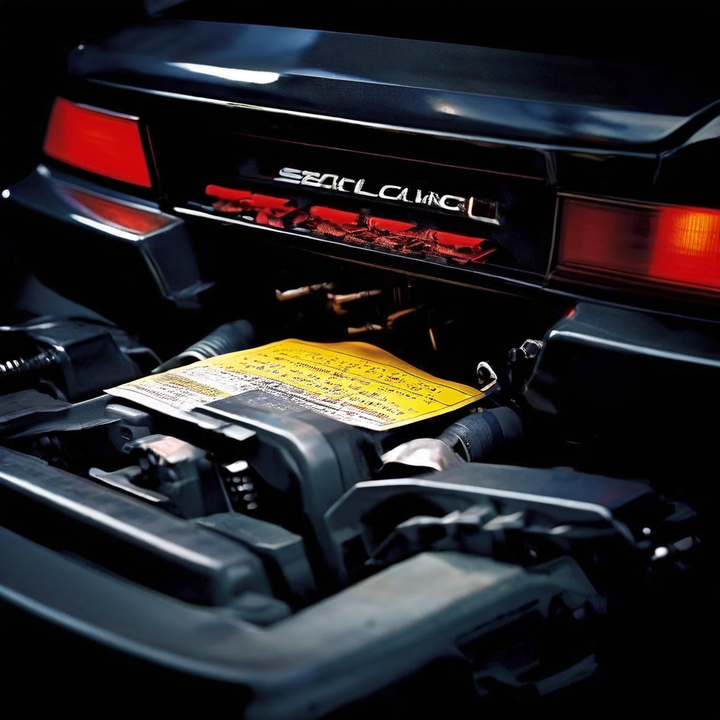


The check engine light, also known as the malfunction indicator lamp (MIL), is a crucial component of modern vehicles' onboard diagnostics systems. It serves as a warning signal to alert drivers of potential issues within the vehicle's engine or emissions control systems.

The check engine light can be triggered by various factors related to an oil change. Here's a table summarizing the common culprits:
| Cause | Description |
|---|---|
| Low Oil Level | If the wrong amount of oil is added during the service, it can trigger the low oil pressure sensor, causing the warning light to illuminate. |
| Loose or Faulty Gas Cap | A loose or damaged gas cap can cause an evaporative leak, setting off the check engine light. |
| Incorrect Oil Type | Using an oil viscosity or specification not recommended for your vehicle can cause issues with the engine and trigger warning lights. |
| Disturbed Sensors or Connections | Sensors or electrical connections around the engine area may be accidentally disturbed or disconnected during the oil change process. |
| Oil Filter Issues | An improperly installed or faulty oil filter can restrict oil flow and pressure, leading to the check engine light illumination. |
Let's dive deeper into each of these causes and explore the steps you can take to address them.
One of the most common reasons for the check engine light to come on after an oil change is a low oil level. During the service, if the wrong amount of oil is added, it can trigger the low oil pressure sensor, causing the warning light to illuminate.
To rectify this issue, follow these steps:
Check the oil level using the dipstick.
Ensure the oil level is within the proper range specified in your vehicle's owner's manual.
If the oil level is low, top up with the correct amount and type of oil recommended for your vehicle.
Believe it or not, a loose or damaged gas cap can also be the culprit behind the check engine light's appearance. This seemingly unrelated issue can cause an evaporative leak, setting off the warning light.
Here's what you can do:
Inspect the gas cap to ensure it's tightened properly and not damaged.
If the gas cap is loose or damaged, tighten or replace it with a new one.
Using an incorrect oil viscosity or specification not recommended for your vehicle can cause issues with the engine and trigger warning lights. Always refer to your owner's manual or consult with a professional mechanic to ensure you're using the correct oil type for your specific make and model.
If you've used the wrong oil type, follow these steps:
Drain the oil from your vehicle.
Replace the oil filter with a new, high-quality filter.
Refill the engine with the correct oil specification recommended for your vehicle.
During an oil change, sensors or electrical connections around the engine area may be accidentally disturbed or disconnected. This can cause the check engine light to turn on as a warning signal.
To address this issue:
Visually inspect the engine area for any loose or disconnected sensors or wiring.
Reconnect or replace any loose or damaged sensors or wiring harnesses.
An improperly installed or faulty oil filter can restrict oil flow and pressure, leading to the check engine light illumination.

Here's what you can do:
Ensure the oil filter is properly installed according to the manufacturer's instructions.
Use high-quality oil filters designed specifically for your vehicle.
If the oil filter is damaged or restricted, replace it with a new one.
If you find yourself staring at the glowing check engine light after an oil change, don't panic! Here are the steps you can take to inspect and diagnose the issue:
Check the Oil Level: Use the dipstick to ensure the oil level is within the proper range. Top up if needed.
Inspect the Gas Cap: Check if the gas cap is tightened properly and not damaged.
Verify the Oil Type: Confirm that the correct oil type and viscosity were used for your vehicle.
Visual Inspection: Visually inspect for any loose or disconnected sensors or wiring around the engine area.
Oil Filter Check: Ensure the oil filter is properly installed and not damaged or restricted.
OBD-II Scanner: Use an OBD-II scanner to retrieve any diagnostic trouble codes, which can help pinpoint the specific issue.
Once you've identified the potential cause, follow these repair instructions to address the issue:
| Cause | Repair Instructions |
|---|---|
| Low Oil Level | Add the correct amount and type of oil recommended for your vehicle. |
| Loose Gas Cap | Tighten or replace the gas cap if damaged. |
| Wrong Oil Type | Drain the oil, replace the filter, and refill with the correct oil specification. |
| Disturbed Sensors/Connections | Reconnect or replace any loose or damaged sensors or wiring. |
| Oil Filter Issues | Replace the oil filter with a new, high-quality filter and ensure proper installation. |
To avoid future occurrences of the check engine light after an oil change, follow these preventive measures:
Follow Recommended Intervals: Adhere to the recommended oil change intervals and use the correct oil type and quantity.
Tighten the Gas Cap: Ensure the gas cap is properly tightened after refueling.
Exercise Caution: Be cautious when working around sensors and wiring during maintenance to avoid accidental disconnections.
Use High-Quality Filters: Invest in high-quality oil filters and follow the proper installation procedures.
The cost of addressing a check engine light issue after an oil change can vary depending on the specific cause:
| Cause | Typical Cost |
|---|---|
| Low Oil Level or Loose Gas Cap | Minimal cost, typically just the price of adding oil or a new gas cap. |
| Wrong Oil Type | Cost of an oil change service, including labor and new oil/filter. |
| Sensor or Wiring Issues | Repair costs can range from moderate to expensive, depending on the specific sensor or wiring harness involved. |
| Oil Filter Issues | Relatively inexpensive, typically just the cost of a new filter and labor. |
It's recommended to have a professional mechanic diagnose and repair the issue to ensure it's properly resolved and prevent potential engine damage from occurring.
While an illuminated check engine light after an oil change can be concerning, it's often a straightforward issue to resolve. By understanding the potential causes, performing proper inspections, and following preventive measures, you can keep your vehicle running smoothly and avoid unnecessary stress.
Remember, regular maintenance and attention to detail are key to maintaining a healthy and reliable vehicle. Don't hesitate to seek professional assistance if you're unsure about any aspect of the repair process. Happy motoring, and may your check engine light remain dark!
No, there could be other reasons like a loose or faulty gas cap, using the wrong oil type, disturbed sensors/connections, or issues with the oil filter.
Refer to your vehicle's owner's manual or consult with a professional mechanic to ensure you're using the recommended oil type and viscosity.
Yes, a loose or damaged gas cap can cause an evaporative leak, which can set off the check engine light as a warning signal.
Visually inspect the engine area, reconnect or replace any loose or damaged sensors or wiring harnesses to resolve the issue.
Ensure the oil filter is properly tightened according to the manufacturer's instructions and not damaged or restricted in any way.
Yes, an OBD-II scanner can retrieve diagnostic trouble codes, which can help pinpoint the specific cause of the check engine light illumination.
It's generally safe to drive for a short distance, but it's recommended to address the issue promptly to prevent potential engine damage.
Follow the recommended oil change intervals specified in your vehicle's owner's manual, typically every 3,000 to 5,000 miles or as recommended by the manufacturer.
Yes, a faulty oil pressure sensor can trigger the check engine light, as it may incorrectly detect low oil pressure or other issues.
While some issues may be straightforward to address, it's generally recommended to have a professional mechanic diagnose and repair the issue to ensure it's properly resolved and prevent potential engine damage.

Sarah isn't your average gearhead. With a double major in Mechanical Engineering and Automotive Technology, she dived straight into the world of car repair. After 15 years of turning wrenches at dealerships and independent shops, Sarah joined MICDOT to share her expertise and passion for making cars run like new. Her in-depth knowledge and knack for explaining complex issues in simple terms make her a valuable asset to our team.













